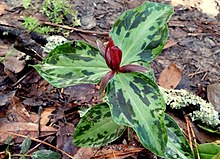| Trillium foetidissimum | |
|---|---|

| |
| Trillium foetidissimum in bloom in Baton Rouge, LA, USA | |
|
Scientific classification
| |
| Kingdom: | Plantae |
| Clade: | Tracheophytes |
| Clade: | Angiosperms |
| Clade: | Monocots |
| Order: | Liliales |
| Family: | Melanthiaceae |
| Genus: | Trillium |
| Species: | T. foetidissimum
|
| Binomial name | |
| Trillium foetidissimum
J.D.Freeman, 1975
| |
| Synonyms [2] | |
| |
Trillium foetidissimum, also known as the Mississippi River wakerobin, stinking trillium, or fetid trillium, [3] [4] [5] is a species of flowering plant in the family Melanthiaceae. It is found along the Louisiana– Mississippi border [6] in a variety of habitats.
Trillium foetidissimum is a perennial herbaceous plant that blooms from early March to early April. [3]
Description
The plant is brown colored with horizontal rhizomes and bracts. It carries 1-2 scapes which are 0.8–2.8 decimetres (3.1–11.0 in) from green to maroon-colored and are round at cross section. Leaves are either light or bronze-green in color. Sepals are located above the bracts and are green colored, horizontal, and lanceolate. They are 16–40 millimetres (0.63–1.57 in) long and 4–6 millimetres (0.16–0.24 in) wide and are thick. Petals are erect while apex is acute. Flaments are 3–6 millimetres (0.12–0.24 in) long and are dark maroon in color while stamens are 9–25 millimetres (0.35–0.98 in) and are both erect and prominent. Anthlers are straight, 8–15 millimetres (0.31–0.59 in) long, and are blackish-maroon in color. The species also have erect and ovate ovary which is 5–12 millimetres (0.20–0.47 in) long and is reddish-purple in color. Stigma is also erect and dark purple in color but is subulate and fleshy unlike the ovary. The flower is sessile, of a maroon color fading to brown with narrow lanceolate petals. It emits a smell of rotting meat to attract insect pollinators, hence the name. Its leaves are strongly mottled. The flower turns to a purple-brown berry in autumn. [3]
References
- ^ "Trillium foetidissimum". NatureServe Explorer. NatureServe. Retrieved 16 November 2021.
- ^ "Trillium foetidissimum". World Checklist of Selected Plant Families (WCSP). Royal Botanic Gardens, Kew.
- ^ a b c Case Jr., Frederick W. (2002). "Trillium foetidissimum". In Flora of North America Editorial Committee (ed.). Flora of North America North of Mexico (FNA). Vol. 26. New York and Oxford: Oxford University Press – via eFloras.org, Missouri Botanical Garden, St. Louis, MO & Harvard University Herbaria, Cambridge, MA.
- ^ Stritch, Larry. "Stinking Trillium (Trillium foetidissimum)". United States Forest Service. Retrieved 7 October 2019.
- ^ USDA, NRCS (n.d.). "Trillium foetidissimum". The PLANTS Database (plants.usda.gov). Greensboro, North Carolina: National Plant Data Team. Retrieved 15 December 2015.
- ^ "Trillium foetidissimum". County-level distribution map from the North American Plant Atlas (NAPA). Biota of North America Program (BONAP). 2014. Retrieved 7 October 2019.
- Frett, Jeanne (2007). Trilliums at Mt. Cuba Center: A Visitor's Guide. Mt. Cuba Center Inc. ISBN 978-0-9770848-1-4.
External links
- Citizen science observations for Trillium foetidissimum at iNaturalist
- Biodiversity Information Serving Our Nation (BISON) occurrence data and maps for Trillium foetidissimum
